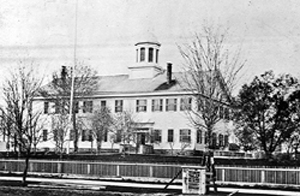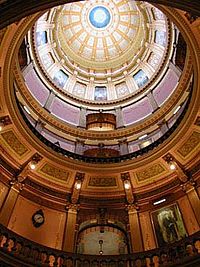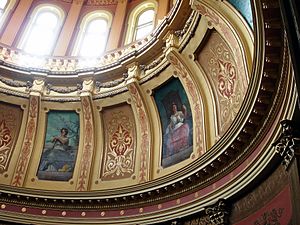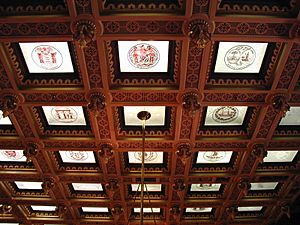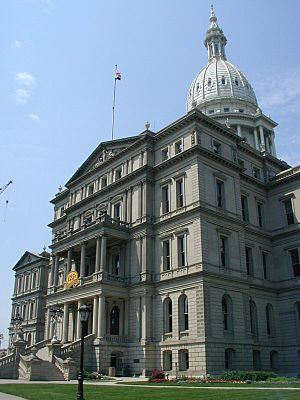Michigan State Capitol facts for kids
Quick facts for kids Michigan State Capitol |
|
|---|---|
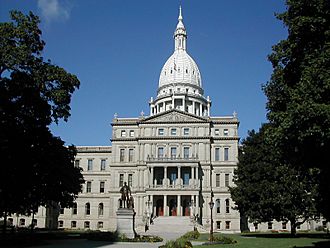
A statue of Austin Blair stands in the foreground
|
|
| General information | |
| Architectural style | Neoclassical/Italianate/Renaissance revival |
| Location | 100 N Capitol Ave, Lansing, Michigan, U.S. |
| Coordinates | 42°44′01″N 84°33′20″W / 42.733601°N 84.555470°W |
| Groundbreaking | 1872 |
| Construction started | Cornerstone laid: October 2, 1873 |
| Completed | September 26, 1878 |
| Inaugurated | January 1, 1879 |
| Renovated | 1989–1992; 2010–2014 |
| Cost | $1,427,738.78 |
| Height | 267 feet (81 meters) |
| Dimensions | |
| Diameter | 128 m × 83.5 m (420 ft × 274 ft) |
| Technical details | |
| Lifts/elevators | 2 |
| Design and construction | |
| Architect | Elijah E. Myers |
|
Michigan State Capitol
|
|
| Architectural style | Renaissance |
| MPS | Downtown Lansing MRA (AD) |
| NRHP reference No. | 71000396 |
| Significant dates | |
| Added to NRHP | January 25, 1971 |
| Designated NHL | October 5, 1992 |
The Michigan State Capitol is a very important building in Michigan. It is where the state's laws are made and where the Governor and Lieutenant Governor have their special offices. This amazing building is located in Lansing, Michigan, which is the capital city of Michigan.
The Michigan State Capitol is a National Historic Landmark. This means it is a very special place in American history. It is actually the third building that has served as the home for Michigan's government. The first capital was in Detroit, but it was moved to Lansing in 1847. This move helped develop the western part of the state. It also offered better protection from any potential threats.
Contents
History of Michigan's Capitol Buildings
The First State Capitol in Detroit
Michigan became a territory in 1805, with Detroit as its capital. Michigan wanted to become a state, but there was a disagreement with Ohio over a piece of land called the Toledo Strip. This disagreement was even called the "Toledo War."
To become a state, Michigan had to give up its claim to the Toledo Strip. In return, it received the eastern part of the Upper Peninsula. Michigan officially became the 26th state on January 26, 1837. Detroit remained the first capital.
The first building used as the State Capitol was built in 1832. It was originally a courthouse. This brick building was designed in the Greek Revival style. It had tall columns and a central tower. It cost $24,500 to build. This building served the government until 1848. After that, it became a public school and library. Sadly, it burned down in 1893.
The Second State Capitol in Lansing
The Michigan Constitution of 1835 said that the capital could be moved after 1847. Detroit wanted to keep the capital, but people in the western part of the state wanted it moved. They wanted the government to be closer to more people. They also wanted it to be safer from the Canada-US border.
Many cities wanted to be the new capital, like Ann Arbor and Jackson. Finally, a state senator suggested Lansing Township. This area was mostly empty but was a good central location. The legislature agreed, and Lansing became the new capital.
Construction on the second capitol building in Lansing began in 1847. It was a simple, two-story wooden building. It was painted white with green shutters and had a tin dome. The total cost was about $23,000. This temporary building was sold when the current capitol opened in 1879. Like the first capitol, it was destroyed by fire in 1882.
The Current State Capitol Building
In the early 1870s, Governor Henry P. Baldwin pushed for a new, permanent capitol building. A bill was passed in 1871 to build it. The new capitol was planned to cost $1.2 million.
In 1872, Elijah E. Myers was chosen as the architect. His design was called Tuebor, which means I will defend. Myers used a design similar to the United States Capitol in Washington D.C. He also designed the state capitol buildings for Colorado and Texas.
The first stone, called the cornerstone, was laid on October 2, 1873. About 7,000 Lansing residents and many visitors attended the event. The building was finished by late 1878. The new capitol, with 139 rooms, was officially opened on January 1, 1879. This was also when Governor Charles Croswell took office.
The Lansing capitol building was designed to be fireproof. It was also large enough for the growing state government. It even stored important items from the American Civil War, like battle flags. These flags were later moved to the Michigan Historical Museum in 1990.
Over the years, the dome was repainted a bright white. However, a major restoration from 1989 to 1992 changed it back to a creamy-white color. This restoration also updated the building's systems and made it easier for everyone to access. Many original design features were brought back. The Capitol Building was added to the National Register of Historic Places in 1971. It became a National Historic Landmark in 1992.
The Capitol Building Today
Building Features and Design
The Michigan State Capitol is very tall, reaching 267 ft (81 m) to the top of its spire. The building is 420 ft 2 in (128.07 m) long and 273 ft 11 in (83.49 m) wide. It covers about 1.16 acres (4,700 m2) of land. The building has four floors, with public entrances on the ground floor. Two large staircases lead up to the top floor.
The main rotunda area is 44.5 feet (13.6 m) wide and 160 feet (49 m) tall. When the Capitol first opened, it held all the state offices. Now, only the offices for the Senate and House leaders, and the ceremonial offices for the governor and lieutenant governor, are still in the building.
The ground floor used to be for storage. Today, it has offices for the Secretary of the Senate and the Clerk of the House. It also has the Capitol Tours and Information Service. The original wooden floor has been replaced with gray tiles.
The floors from the first to the third story are made of black and white Vermont marble and limestone. But the floor of the rotunda is special. It has 976 clear glass blocks. These blocks let light shine down to the floor below. When you look down from the upper floors, the glass blocks look like a bowl. This mirrors the dome above.
The doorknobs in the building are mostly made of a brass and bronze mix. They show the state's coat of arms. Even though the wood looks like walnut, it is actually Michigan white pine. It was painted to look like walnut.
On the first floor, you can see the beautiful interior of the rotunda. The ceiling under the dome has eight muses painted on it. For a long time, no one knew who painted them. Now we know it was Tommaso Juglaris. He painted them in his Boston studio.
The second floor has the governor's offices. It also features the Gallery of Governors. This gallery has portraits of all the past Michigan Governors. The governor's offices were carefully restored to look like they did in 1876. The former Michigan Supreme Court chambers are also on this floor. They are now used by the Senate Appropriations Committee.
The third floor is where you can visit Michigan's lawmaking bodies. The Capitol building has the chambers for the Michigan House of Representatives and the Michigan Senate. These are the two parts of the state legislature. Public viewing areas are at both ends of the third floor.
The Senate has 38 members and is on the south side of the building. The House of Representatives has 110 members and is in the north wing. Both houses have sessions on Tuesdays, Wednesdays, and Thursdays. Sometimes they meet on Mondays and Fridays too. Their sessions are shown live on Michigan Government Television.
The House and Senate chambers look different, even though they have the same layout. The House is decorated in terra cotta and teal colors. The Senate is decorated in blue and gold. The carpet at the entrance to the House chamber has the apple blossom, which is the state flower.
The Speaker leads the House. The Lieutenant Governor leads the Senate. Both the House and Senate use computer voting systems. They also have glass-tiled ceilings. These ceilings let natural light shine through etched glass panels. The ceiling tiles show the coats-of-arms of every state in the United States.
In 2013, the building had more work done. The old carpets were replaced, and the wiring for communications was updated. Roof leaks were fixed, and a handicapped parking area was improved.
Capitol Grounds and Memorials
Above the main entrance is a sculpture called "The Rise and Progress of Michigan." It shows a figure representing Michigan, dressed as a Native American. She is offering a book and a globe, promising a bright future. Around her are symbols of Michigan's economy, like farming, shipping, mining, and lumber.
The cornerstone of the building is on the northeast corner. It has the dates 1872 (when construction started) and 1878 (when it finished). In 1978, the stone was opened for the building's 100th anniversary. Documents inside were damaged, but coins were still there. Officials put 38 new items inside to represent Michigan's history today.
On the lawn's southeast corner is the Grand Army of the Republic Memorial. This bronze plaque was placed in 1924. It honors the American Civil War veterans who fought for the Union.
The Capitol grounds also have several important trees. An Eastern White Pine, Michigan's state tree, is at the front of the building. The Dr. Martin Luther King Jr. Tree was planted in 1984 to remember the slain leader.
The oldest tree on the grounds is a catalpa tree. It was there when the Capitol was dedicated in 1873. The American Forestry Association says this catalpa is the largest of its kind in the United States. A blue spruce called "the Freedom Tree" was planted in 1973. It is a memorial to those missing or captured during the Vietnam War.
National Guard Security in 2021
Before the 2021 Inauguration of Joe Biden, the Michigan National Guard was called in. They provided extra security at the Michigan State Capitol. This was in response to warnings about possible protests at state capitals across the U.S.
Images for kids
See also
 In Spanish: Capitolio del Estado de Míchigan para niños
In Spanish: Capitolio del Estado de Míchigan para niños



